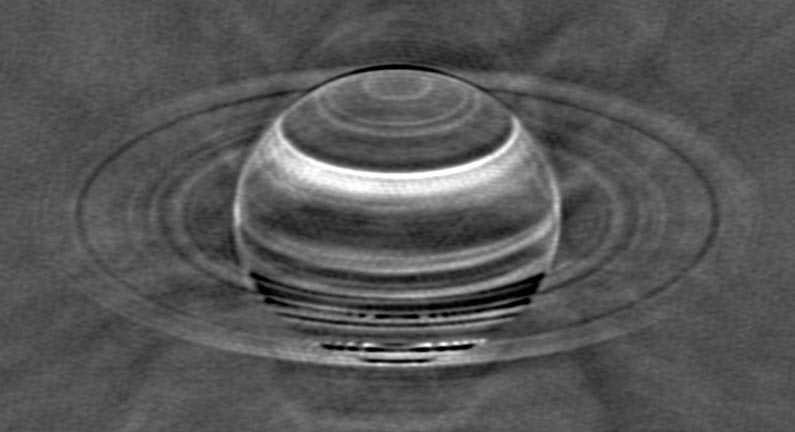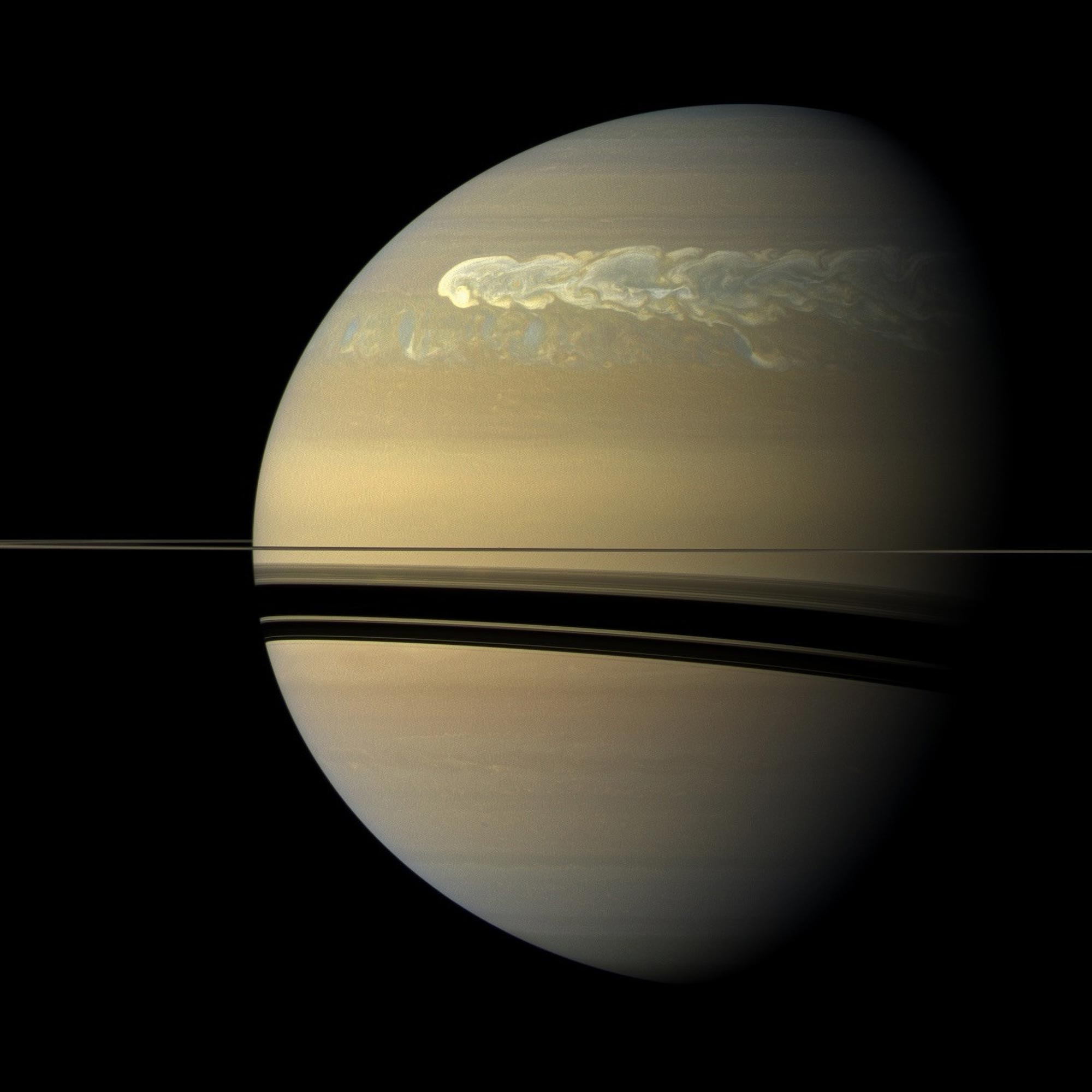

During its seven-year Solstice mission, Cassini watched as a huge storm broke out and surrounded Saturn. Scientists believe that such storms are related in part to the seasonal effects of sunlight on Saturn’s atmosphere. Image credit: NASA/JPL-Caltech/Space Science Institute
Huge storms leave marks on Saturn’s atmosphere for centuries.
Researchers have discovered long-period giant storms Saturnis similar to JupiterGreat Red Spot, by studying radio emissions and disturbances of ammonia gas. The research reveals significant differences in the atmospheres between gas giants, challenges current understanding of giant storms, and provides new insights that may influence future studies on exoplanets.
The Great Red Spot and new discoveries on Saturn
The largest storm in the solar system, a 10,000-mile-wide anticyclone known as the Great Red Spot, has graced the surface of Jupiter for hundreds of years.
A new study reveals that Saturn, although more modest in appearance compared to Jupiter’s colorful appearance, also has giant, long-lasting storms. These storms have profound effects in the atmosphere that last for centuries.
Study methodology
The research was conducted by astronomers University of California, Berkeleyand the University of Michigan Ann Arbor. They examined radio emissions from the planet, which originate from beneath the surface, and discovered long-term disturbances in the distribution of ammonia gas.
The study is published Aug. 11 in the journal Science advances.

A radio image of Saturn was taken with the VLA in May 2015, with brighter radio emissions from Saturn and its rings subtracted to enhance the contrast in fainter radio emissions between different latitudinal bands in the atmosphere. Because ammonia blocks radio waves, bright features indicate regions where ammonia is depleted and the VLA can see deeper into the atmosphere. The wide bright band at northern latitudes is the aftermath of a 2010 storm on Saturn, which apparently exhausted ammonia gas below the icy ammonia cloud, which is what we see with the naked eye. Credit: RJ Salt and E.D. Butter
The nature of mega storms
Giant storms occur about every 20 to 30 years on Saturn and are similar to hurricanes on Earth, although much larger. But unlike Earth’s hurricanes, no one knows why the massive storms occur in Saturn’s atmosphere, which is primarily hydrogen and helium with traces of methane, water and ammonia.
“Understanding the mechanisms of the solar system’s largest storms places hurricane theory in a broader cosmic context, challenging our current knowledge and pushing the boundaries of terrestrial meteorology,” said lead author Cheng Li, a former UCLA 51 Peg b fellow. Berkeley, and is now an assistant professor at the University of Michigan.
exploration and tools
Imke de Pater, UC Berkeley Professor Emeritus of Astronomy and Earth and Planetary Sciences, has been studying gas giants for more than four decades to better understand their composition and what makes them unique, using the Karl G. Jansky Very Large Array in New Mexico to probe radio emissions from deep within the planet. .

In the visual field, Saturn’s banded atmosphere appears to shift smoothly from color to color. But seen here in radio light — the VLA data overlaid on a Cassini image of Saturn — the distinct nature of the bands is clear. Scientists used VLA data to better understand ammonia in the gas giant’s atmosphere and learned that giant storms transport ammonia from the upper atmosphere to the lower atmosphere. Credit: S. Dagnello (NRAO/AUI/NSF), I. de Pater et al (UC Berkeley)
“At radio wavelengths, we probe beneath visible cloud layers on giant planets. Because chemical reactions and dynamics will alter the composition of a planet’s atmosphere, observations below these cloud layers are required to constrain the composition of the planet’s true atmosphere, which is a key parameter for models of planet formation.” “Radio observations help characterize dynamic, physical, and chemical processes including heat transfer, cloud formation, and convection in the atmospheres of giant planets at both the global and local scales.”
Surprising results
As reported in the new study, UC Berkeley graduate student Chris Moeckel, de Pater, found something surprising in the planet’s radio emissions: anomalies in the concentration of ammonia in the atmosphere, which they linked to previous events of massive storms in the hemisphere. north of the planet.
Effect on ammonia concentration and atmospheric differences
According to the team, the ammonia concentration is low at mid-altitudes, below the upper cloud layer of ammonia ice, but becomes enriched at lower altitudes, 100 to 200 kilometers deeper in the atmosphere. They believe that ammonia is transported from the upper atmosphere to the lower atmosphere through precipitation and re-evaporation processes. Moreover, this effect could last for hundreds of years.
Comparing Saturn and Jupiter
The study further revealed that although both Saturn and Jupiter are made of hydrogen gas, these two gas giants are markedly different. While Jupiter does have tropospheric anomalies, they are bound by its regions (white bands) and belts (dark bands) and are not caused by storms as they are on Saturn. The significant difference between neighboring gas giants challenges current understanding of the formation of giant storms on gas giants and other planets. It may also affect how these storms are found and examined on exoplanets in the future.
Reference: “The Deep Long-Term Impact of Saturn’s Giant Storms” By Cheng Li, Emke de Pater, Chris Moeckel, RJ Salt, Brian Butler, David de Boer and Zhiming Zhang, Aug. 11, 2023, Available here. Science advances.
DOI: 10.1126/sciadv.adg9419
The National Radio Astronomy Observatory (NRAO) is a facility of the National Science Foundation, operated under a cooperative agreement by Associated Universities Inc.

“Web maven. Infuriatingly humble beer geek. Bacon fanatic. Typical creator. Music expert.”





More Stories
Scientists confirm that monkeys do not have time to write Shakespeare: ScienceAlert
SpaceX launches 23 Starlink satellites from Florida (video and photos)
A new 3D map reveals strange, glowing filaments surrounding the supernova